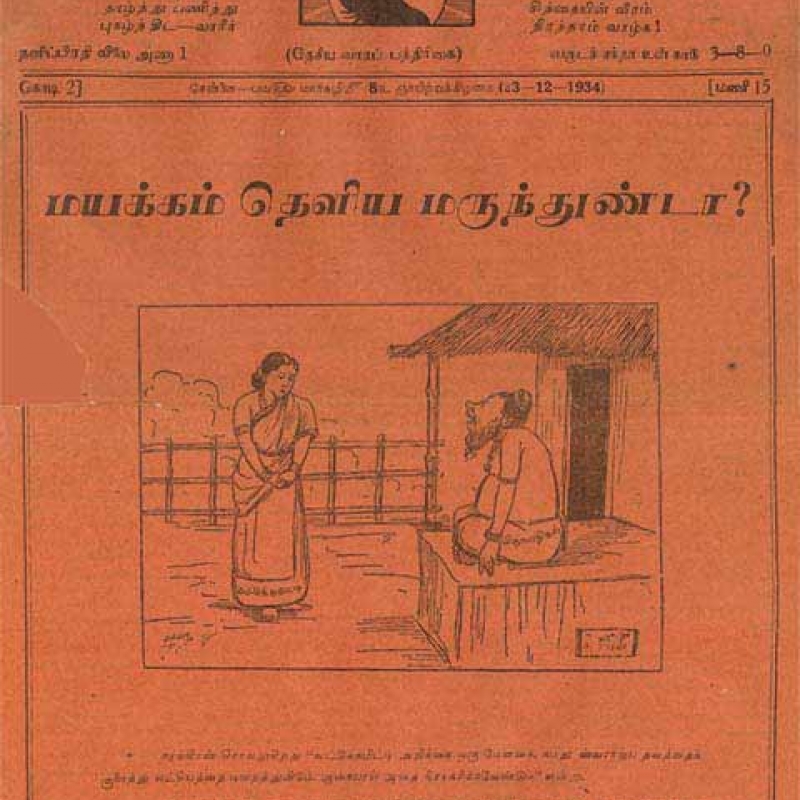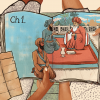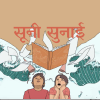Manikodi has an iconic place in modern Tamil literature. Well into the late 20th century, writers claimed descent—a claim that was often contested—from the journal, and called themselves, Manikodi Ezhuthalargal, or ‘Manikodi writers’. On the other hand, many writers, especially of leftist persuasion, used it in a pejorative sense, to refer to writers who had no social commitment. The rival celebrations of its golden jubilee, in 1983, indicates its continuing importance and its contestation.
Manikodi was closely associated with the idea of a ‘marumalarchi’ (a Tamil neologism for ‘renaissance’), and it is credited with the flowering, maturation and naturalization of the genre of the short story in Tamil. The Tamil short story greats, Pudumaippithan and Ku. Pa. Rajagopalan wrote extensively in Manikodi.
Started in 1933, Manikodi was published in fits and starts, and folded up in 1939. A brief revival in 1950 did not take off.
Context
For a journal that made signal contributions to modern literature, Manikodi started as a political weekly. Its origins lay in the nationalist ferment of the Civil Disobedience Movement (1930–34). Not incidentally, the founders of Manikodi, and many of its contributors were Indian nationalists; closely associated with the Indian National Congress, they were deeply respectful of Gandhi, and had been imprisoned in the movement. Manikodi was launched at a time when there was an explosive growth in the Tamil periodical press. The earliest Tamil periodicals date to the 1840s but until the early 20th century they were characterised by limited print runs and restricted readership. This situation changed with the rise of Indian nationalism as a mass movement, especially under the leadership of Gandhi during the Non-Cooperation Movement.
In the late 1920s, many humorous journals, with the suffix vikatan, were published, drawing in new readers. By the turn of the 1930s emerged a new innovation, called kalana pathirikai (literally, ‘quarter anna magazines’), priced cheaply, employing a racy style, and publicizing news quickly (being published twice or even thrice a week) . Sales peaked to a few thousands of copies. Two of the most prominent quarter anna magazines were Gandhi and Suthanthira Sangu—incidentally their editors and contributors were closely associated with Manikodi. It was at this time that a new system of distribution through newsagents emerged in the Tamil press; until then periodicals were sold largely to subscribers through mail. Agents across the Madras Presidency and also overseas (with significant Tamil diaspora), made cash deposits with the magazines for a regular supply of copies which were sent in bundles on trains and by ship. The agents in turn distributed them through local shops. This system considerably increased the sales and ensured wide distribution but also put the magazines at the mercy of the newsagents. Many magazines suffered huge losses, sometimes even closing down when newsagents defaulted, whether deliberately or not.
First Phase
Manikodi was founded as a weekly, in 1933, by K. Srinivasan (1899–1975), Va.Ra. (Va. Ramaswamy Iyengar, 1889–1951) and T.S. Chockalingam (1899–1966). A graduate of the Madras University, K. Srinivasan had wide experience in the world of English journalism and had been a correspondent in London in the late 1920s. A close associate of S. Sadanand (the founder of the Free Press of India, the first nationalist news agency, and the Free Press Journal), he was taken in by the Sunday Observer of London. In those days no newspaper was published on Sundays, and Srinivasan figured out that the vacuum could be filled with a newsmagazine while also serving the nationalist cause. Va.Ra., an ardent disciple of C. Subramania Bharati, the great nationalist poet, was known for his crusading zeal in writing about social reform, and was endowed with a lively writing style and humour. He had a knack for identifying promising young writers and encouraging them. T.S. Chockalingam, the only non-Brahmin in this trio, came from a nationalist family (his brother being convicted in a conspiracy case in the only political assassination in south India during the freedom struggle). He cut his journalistic teeth under the P. Varadarajulu Naidu, prominent nationalist leader, journalist (founder of the Tamil daily, Tamilnadu and Indian Express) and orator. In 1931, Chockalingam had launched the pioneering quarter anna magazine, Gandhi.
The genesis of Manikodi’s founding has a dramatic touch. All the three founding editors were enthusiasts of Bharati’s poems—incidentally Bharati was riding the first wave of posthumous fame with the publication of his uncollected writings from the late 1920s—and one evening they were sitting on the beach in front of the Fort St George, the seat of government, in Madras. As the sun set, the Union Jack was lowered. The threesome recalled Bharati’s poem, ‘Thayin Manikodi’—a song about the glory of the Indian national flag (manikodi means the jewelled flag)—and dreamt of the day when the English flag would be lowered forever and the Indian flag would fly high in its stead. In this inspired moment, they decided to name their new journal Manikodi.
The first issue of Manikodi was published on September 17, 1933, in the week of Bharati’s 12th death anniversary. Manikodi’s office was first located at 35, Sembudoss Street, George Town, Madras but from February 1934 moved to the 7, Nainiyappan Street, half a kilometre north. Both streets ran parallel to Broadway, the busiest thoroughfare in the city, and the centre of both the periodical press and book publishing.
Manikodi’s first 12 issues were published in full newspaper size (eight pages each). From the 13th issue it was halved into a tabloid size with 20 pages; but the price remained the same, at one anna. The change in size was attributed to complaints by both newsagents and readers that the size was unwieldy. Initially Manikodi was edited by Srinivasan and Va.Ra. with Chockalingam taking a backseat as he was moving to launch a new daily, Dinamani, founded by S. Sadanand. When Va.Ra. and Chockalingam backed out of their financial commitments, Manikodi became the financial responsibility solely of Srinivasan.
Manikodi was animated by a nationalist idealism that was critical of colonialism and the alien government. Additionally, it was critical of moderates and liberals who did not follow Gandhi’s leadership.
Separate rubrics were devised to further nationalist propaganda: Jana Nadai, Nawab Nadai, Swantra Pannai, Pazhang Kanakku, Chaturmugam, Sarukkumalai, Gnanadeepam, Puthu Tharasu. An important rubric was Ilakkiya Cholai, a literary section heralding new writing in Tamil. Pazhang Kanakku invoked history in an impassioned manner to right colonial wrongs. Chaturmugam compiled news from various sources in an interesting manner. Sarukkumalai put together quotations, usually from political rivals, and commented on them. Manikodi also published political cartoons regularly.
Manikodi carried many memorable features. Srinivasan rewrote the Ramayana in the manner of a contemporary reporter filing stories. Inspired by Hilaire Belloc and A.G Gardiner, Va.Ra. wrote a series of sketches on archetypal characters under the rubric of ‘nadaichithiram’ which are read to this day. Manikodi also pioneered verse libre or free verse in Tamil by publishing the prose poems of Ku.Pa. Rajagopalan. It also published many poems by Bharatidasan, despite his non-Brahmin movement politics being at variance with Manikodi’s.
Not only was Manikodi self-conscious about its literary quality, it was also received in the same manner. However, its circulation was limited and did not cross 1000. Manikodi’s rival was Ananda Vikatan, published by S.S. Vasan (later to be the movie mogul of Gemini Studios) and edited by ‘Kalki’ R. Krishnamurthy. An outcome of the rivalry was the bitter polemic, in 1934, following Ananda Vikatan’s adoption of the new American game of crossword puzzles with tempting prizes; Manikodi cried foul and decried it as a mercenary ploy.
Manikodi, Ananda Vikatan and Kalaimagal represented three different trends in the making of modern Tamil literature—as presciently delineated by Ku.Pa. Rajgopalan. While Ananda Vikatan took a superficial view of life refusing to engage with the complexities of modern living, Kalaimagal took an idealist view of life at the level of high culture. Manikodi’s credo was rebellion and struggle, and it looked at the underbelly of social life.
In the course of the evolution of modern Tamil literature, while Ananda Vikatan came to represent commercial and philistine writing, Manikodi was seen as the harbinger of serious writing—‘the little magazine’ tradition that emerged from the 1950s as an alternative to the mainstream commercial journals consciously invoked the name of Manikodi. This image of Manikodi was rooted in the form that it took in its second phase.
Second Phase
In the issue of October 21, 1934, appeared an editorial announcement taking exception to the press referring to Va.Ra. as editor of Manikodi. The wording was curt, indicating that the falling out was bitter. With T.S. Chockalingam focused on the new daily Dinamani, Srinivasan was left to fend for himself. With mounting losses, in February 1935, Srinivasan decided to shut shop and left for Bombay to continue his journalistic career in English. At this time Manikodi was being managed by B.S. Ramaiah (1905–83) who had earlier joined Manikodi as an advertisement agent collecting advertisements for a commission. A Congressman who had courted arrest in the Civil Disobedience Movement, he also wrote short stories. Pudumaippithan too was assisting him in running the journal. Ramaiah offered to take over the journal, and a surprised Srinivasan accepted. With this began the second phase of Manikodi, and when latter generations refer to Manikodi, it is often this phase that they allude to.
While Srinivasan’s name continued to appear as editor, it was Ramaiah who ran the show. To settle some financial matters, T.S. Chockalingam’s Gandhi was also formally amalgamated with Manikodi, and the magazine sent to settle subscriptions dues.
Under Ramaiah Manikodi was now a different creature. Firstly, he changed the size: from tabloid it was now reduced to royal octavo. In terms of periodicity it became a fortnightly. Illustrations were introduced with the artist ‘Arya’ (Bashyam) doing many memorable line sketches. But the most important change was in the content. The new Manikodi eschewed politics and news stories and converted itself into a literary review. The focus was on the short story, and the very first issue, numbered anew as Volume 3, Number 1 (March 1, 1935) contained no less than 11 stories. In an innovative move, Ramaiah advertised it with a poster ‘avvvvvvvvvalavum kathaigal’ (untranslatable; eeeeeeeeeeeeeeentirely stories!).
Despite these changes, the base had been laid earlier. Many of the contributors were of the first phase vintage. In fact, Pudumaippithan, the most distinguished of the Manikodi writers, had written over 30 stories in the first phase. These included searing portraits of city life such as ‘Kavandanum Kamanum’, ‘Ponnagaram’ and ‘Theru Vilakku’. ‘Kavandanum Kamanum’ is about low-level prostitution in the streets of Madras; while in ‘Ponnagaram’ a mill worker sells her body to earn a rupee to save her ailing husband. While these stories shocked contemporary readers, in the use of language and narrative technique they retain their literary worth.
Even though he wrote less in the second phase, Pudumaippithan’s stories were longer and more mature. In the relaunched Manikodi he wrote a three-part short story, ‘Thunba Keni’, about the life of indentured labourers set in the tea plantations of Sri Lanka. ‘Sirpiyin Naragam’ (A Sculptor’s Nightmare) writes of the experience of an sculptor finding his masterpiece consecrated in a dark sanctum sanctorum and devotees worshipping it with closed eyes. Manikodi's authors included Ku.Pa. Rajagopalan, Na. Pitchamurthy, N. Chidambara Subramanian, Ci.Su. Chellappa, Ki. Ramachandran, R. Shanmugamsundaram, M.V. Venkatram, ‘Chitti’ P.G. Sunderajan and others. An exciting new find was Mauni, a lionized figure in the history of Tamil fiction. Mauni wrote only 24 stories, inventive in form and content, in his entire career, and most of them were published in Manikodi.
Manikodi also published stories in translation from English, Hindi and Bengali. Some of the Hindi stories were from Premchand’s literary journal Hans.
Each issue of Manikodi was prefaced by an editorial titled ‘Mudal Athiyayam’ (‘First Chapter’). Though criticized by contemporaries for exaggerated claims about the quality of its contents, the editorial bears testimony to the idealism animating Manikodi.
Regular book reviews were published and they expressed sharp opinions, unlike in the mainstream press where book reviews were in the nature of notices. Strong opinions elicited stronger reactions, leading to lively debates. An important debate was on the nature of translation. Until this time adaptations passed for translation, with no established protocols. In this debate major writers argued a case for faithful translation and subsequently it took root, displacing adaptation, both acknowledged and unacknowledged. Another debate between Pudumaippithan and Ku.Pa. Rajagopalan centred on the theme of eroticism in literature.
Despite its critical success, Manikodi was never financially viable. The journal pulled along by the idealism and tenacity of Ramaiah and his friends. Money sent by honest newsagents and a paltry advertising revenue, combined with the patience of the printing press, kept the journal going. In a bid to strengthen its finances Manikodi was converted into a limited company and a book publishing division was added. The new company was called Navayuga Prachuralayam Ltd., and consisted of a board of directors that included K. Srinivasan, T.S. Chockalingam, A.N. Sivaraman, K. Santhanam, P.S. Sankaran, and S.V. Swami. B.S. Ramaiah, apart from being a director, was now designated managing editor of Manikodi. The publishing division published a few good books but the arrangement itself did not help in any way to strengthen its finances.
Rather, internal differences, triggered by the restructuring of the ownership proved to be Manikodi’s undoing. Without any notice, on January 27, 1938 Ramaiah was removed from his managing editorship and Pa. Ramaswamy, a contributor and manager, put in his place. Evidently this was at the instance of T.S. Chockalingam. Ramaiah walked out, severing all ties. Manikodi did not survive for long, published intermittently, and folded up in early 1939. In 1950 Ramaiah tried to revive it, and published five issues.
It might be appropriate to quote from what Pudumaippithan wrote in 1947 less than a year before his death.
No doubt, there have been many literary journals before Manikodi. But there never was a journal, before or after Manikodi, that gave space, encouragement and welcome for new experiments. For the ‘crime’ of founding that journal, the idealist K. Srinivasan lives in linguistic exile working in the English press in another presidency. … In those days, the word ‘marumalarchi’ (renaissance) possessed a new energy and meaning. Some welcomed it. Many ridiculed it. Most people lived unaware of it. Economic adversity committed foeticide on Manikodi and threw it into the municipal trashcan of apathy. My friend Ramaiah, myself and other friends, whose only capital was enthusiasm, salvaged the comatose baby and revived it through the only sustenance of love. After a few years, when the baby had grown into an attractive young girl, we were fortunate to earn a friend who eloped with her. Later he sold her off to another. Soon she attained eternal salvation in this kali age itself. This then is the story of those who built castles for encouraging new experiments in Tamil.












